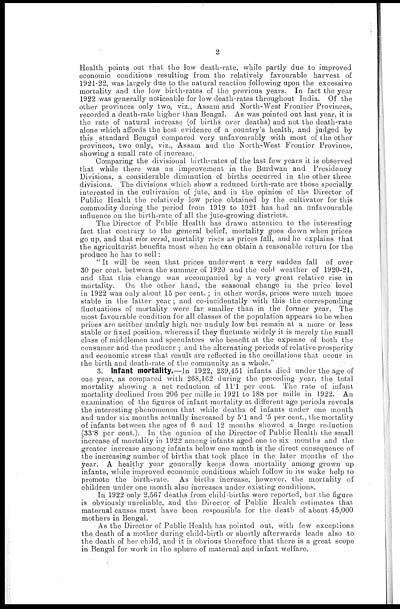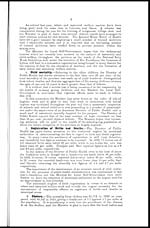Medicine - Vaccination > 1909-1929 - Annual statistical returns and brief notes on vaccination in Bengal > 1920-1923 - Twelfth triennial report of vaccination in Bengal for the years 1920-21, 1921-22 and 1922-23
(499) Page 2
Download files
Individual page:
Thumbnail gallery: Grid view | List view

2
Health points out that the low death-rate, while partly due to improved
economic conditions resulting from the relatively favourable harvest of
1921-22, was largely due to the natural reaction following upon the excessive
mortality and the low birth-rates of the previous years. In fact the year
1922 was generally noticeable for low death-rates throughout India. Of the
other provinces only two, viz., Assam and North-West Frontier Provinces,
recorded a death-rate higher than Bengal. As was pointed out last year, it is
the rate of natural increase (of births over deaths) and not the death-rate
alone which affords the best evidence of a country's health, and judged by
this standard Bengal compared very unfavourably with most of the other
provinces, two only, viz., Assam and the North-West Frontier Province,
showing a small rate of increase.
Comparing the divisional birth-rates of the last few years it is observed
that while there was an improvement in the Burdwan and Presidency
Divisions, a considerable diminution of births occurred in the other three
divisions. The divisions which show a reduced birth-rate are those specially
interested in the cultivation of jute, and in the opinion of the Director of
Public Health the relatively low price obtained by the cultivator for this
commodity during the period from 1919 to 1921 has had an unfavourable
influence on the birth-rate of all the jute-growing districts.
The Director of Public Health has drawn attention to the interesting
fact that contrary to the general belief, mortality goes down when prices
go up, and that vice versâ, mortality rises as prices fall, and he explains that
the agriculturist benefits most when he can obtain a reasonable return for the
produce he has to sell:
"It will be seen that prices underwent a very sudden fall of over
30 per cent. between the summer of 1920 and the cold weather of 1920-21,
and that this change was accompanied by a very great relative rise in
mortality. On the other hand, the seasonal change in the price level
in 1922 was only about 15 per cent. ; in other words, prices were much more
stable in the latter year ; and co-incidentally with this the corresponding
fluctuations of mortality were far smaller than in the former year. The
most favourable condition for all classes of the population appears to be when
prices are neither unduly high nor unduly low but remain at a more or less
stable or fixed position, whereas if they fluctuate widely it is merely the small
class of middlemen and speculators who benefit at the expense of both the
consumer and the producer ; and the alternating periods of relative prosperity
and economic stress that result are reflected in the oscillations that occur in
the birth and death-rate of the community as a whole."
3. Infant mortality.—In 1922, 239,451 infants died under the age of
one year, as compared with 268,162 during the preceding year, the total
mortality showing a net reduction of 11.1 per cent. The rate of infant
mortality declined from 206 per mille in 1921 to 188 per mille in 1922. An
examination of the figures of infant mortality at different age periods reveals
the interesting phenomenon that while deaths of infants under one month
and under six months actually increased by 5.1 and .5 per cent., the mortality
of infants between the ages of 6 and 12 months showed a large reduction
(33.8 per cent.). In the opinion of the Director of Public Health the small
increase of mortality in 1922 among infants aged one to six months and the
greater increase among infants below one month is the direct consequence of
the increasing number of births that took place in the later months of the
year. A healthy year generally keeps down mortality among grown up
infants, while improved economic conditions which follow in its wake help to
promote the birth-rate. As births increase, however, the mortality of
children under one month also increases under existing conditions.
In 1922 only 2,567 deaths from child-births were reported, but the figure
is obviously unreliable, and the Director of Public Health estimates that
maternal causes must have been responsible for the death of about 45,000
mothers in Bengal.
As the Director of Public Health has pointed out, with few exceptions
the death of a mother during child-birth or shortly afterwards leads also to
the death of her child, and it is obvious therefore that there is a great scope
in Bengal for work in the sphere of maternal and infant welfare.
Set display mode to: Large image | Zoom image | Transcription
Images and transcriptions on this page, including medium image downloads, may be used under the Creative Commons Attribution 4.0 International Licence unless otherwise stated. ![]()
| Permanent URL | https://digital.nls.uk/91543019 |
|---|
| Additional NLS resources: | |
|---|---|



![[Page 1]](https://deriv.nls.uk/dcn4/9154/91543018.4.jpg)
